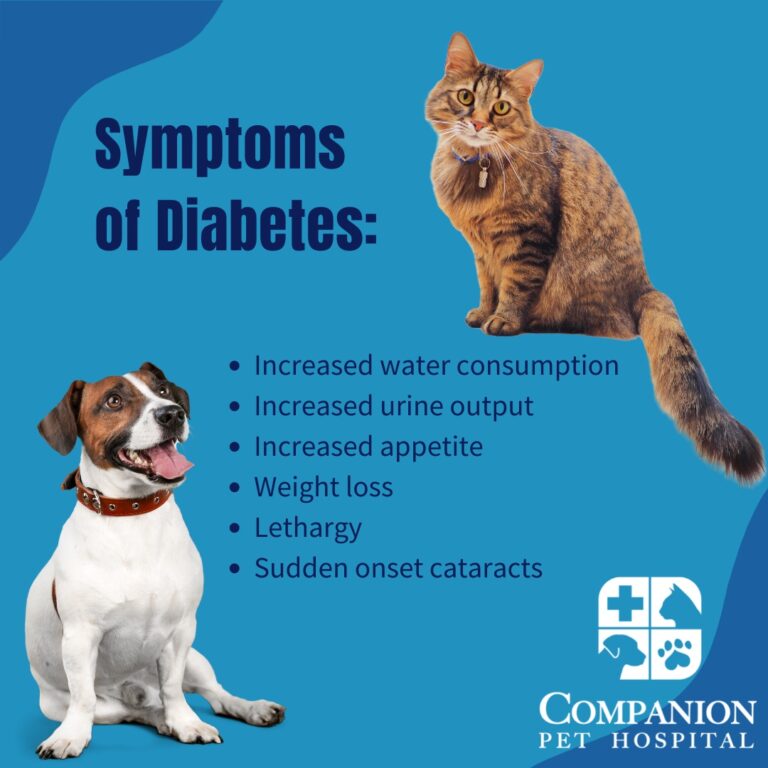Diabetes: What Every Pet Parent Should Know

Authored by Dr. Hope Jankunas
In honor of Pet Diabetes Month, we are raising awareness by providing an overview of the disease and giving tips for how pet parents can be involved in maintaining their pet’s health.
What is Diabetes?
Diabetes is an illness that affects a pet’s ability to make or use insulin. Insulin is the hormone the body uses to break down food to use for energy. When this process doesn’t work, pets feel tired and lose weight. Glucose (sugar) levels in the blood rise and cause symptoms such as increased thirst and urination. If left untreated, the body will begin to use stored fat for energy. Ketones are by-products of this process and lead to severe illness characterized by extreme lethargy, vomiting and loss of appetite.
What causes Diabetes?
Insulin Deficiency Diabetes (Type 1 Diabetes) is a decreased production of insulin. This tends to be an inherited condition and is common in certain breeds such as Schnauzers, Cocker Spaniels, and Poodles. It can also be a complication of pancreatitis, which is a disease that affects the organ where insulin is made.
Insulin Resistance Diabetes (Type 2 Diabetes) occurs when the body does not respond properly to insulin. Obesity, infections, and excess steroids are risk factors. High steroid levels can be caused by Cushing’s Disease or long-term prednisone use.
How is Diabetes diagnosed?
Your vet can perform two simple tests to look for elevated glucose levels in both the blood and urine. A full blood panel and urinalysis are essential to evaluate whether other complications are present and require treatment. A Fructosamine test confirms Diabetes by showing that high blood sugar levels have been an ongoing problem and not just a short-term stress response (seen commonly in cats and does not require treatment).
How is Diabetes treated?
Treatment almost always includes Insulin, which is given twice a day by injection. Researchers have been looking at oral treatments available for people, but unfortunately these don’t appear to work in cats and dogs.
Additionally, many pets require a weight loss plan and to have any complicating issues (such as infections, Cushing’s Disease, and Thyroid problems) treated as well.
Diabetic pets need to follow-up regularly with their vet to monitor response to treatment. Specifically, vets are looking for improvement in symptoms and lower blood glucose levels. Dose adjustments are usually necessary in the first few months of treatment.
How can pet parents contribute to caring for their diabetic pet?
Patients have better outcomes when pet parents actively participate in at-home monitoring. Here are some tools that can help:
- The FreeStyle Libre Continuous Glucose Monitoring device is applied to the pet’s skin and a small needle takes continuous blood sugar readings that are displayed on a handheld reader. The data is sent directly to the vet so they can see how the patient’s blood sugar responds to insulin. Each monitor lasts 10-14 days and is an especially helpful tool early in the treatment process and any time dose adjustments are made.
- The AlphaTrak handheld glucometer can be used to get blood sugar readings at home using a single drop of blood. Pet parents can learn how to use this tool during a quick training session with a veterinary technician. It’s helpful to be able to test blood sugar at home if your diabetic pet is not acting right.
- The Smart Cat Box urine collection system allows urine glucose and ketone levels to be measured at home from the cat’s litterbox. The presence of ketones or persistently elevated glucose levels require veterinary attention.
- Pet Diabetes Apps allow pet parents to track diabetes symptoms on a smart phone. Or if you prefer, keep a journal or jot the information on a calendar. Either way, the vet is going to need to know about the patient’s symptoms to make decisions about insulin dose adjustments.
Can Diabetes be prevented?
Treating conditions that are known risk factors for insulin-resistance, including maintaining a healthy body weight, can prevent Diabetes. In cases where Diabetes cannot be prevented, early diagnosis and treatment offer the best chance for a success and an improved quality of life. Monitor your pet for symptoms and bring them to the vet if you notice anything abnormal. Have a physical exam and screening tests performed regularly—that’s yearly for middle-aged pets and twice a year for senior pets.
Companion Pet Hospital is honored to partner with you in caring for your pet. We’d love to hear from you – please contact us with any questions!

